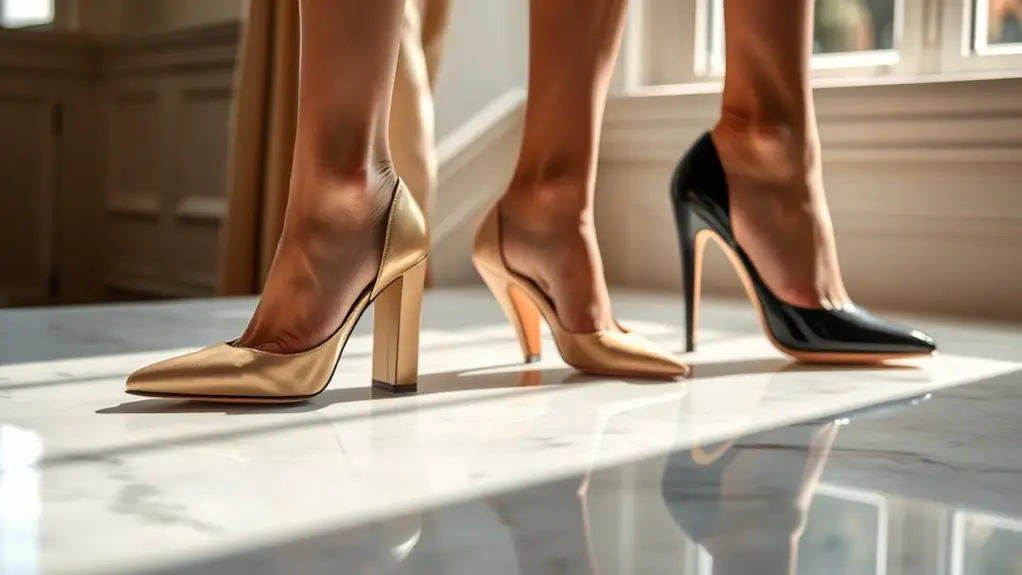For safe walking, opt for low heels (up to 2 inches). They provide comfort, even weight distribution, and better stability, reducing the risk of falls and injuries. Mid heels (2-3 inches) strike a balance between style and support, suitable for occasions where you won’t be on your feet all day. High heels can alter your gait and lead to foot and posture issues. Understanding heel heights is important, and there’s more to explore about finding the best options for you.
Understanding Heel Heights: The Basics

When it comes to choosing the right heel height, understanding the basics is vital for both comfort and safety. Your heel height can notably affect your foot health, influencing posture, balance, and overall well-being. Generally, lower heels—up to 2 inches—are recommended for everyday wear as they provide better stability and reduce strain on your feet.
As heel height increases, the risk of discomfort and injury grows. Mid-height heels, ranging from 2 to 3 inches, can be suitable for occasional use but may require more attention to foot alignment. High heels, over 3 inches, often lead to altered gait and increased pressure on the forefoot, potentially resulting in long-term issues like plantar fasciitis or bunions.
It’s important to take into account your activity level and foot structure when selecting heel height to maintain ideal foot health while enjoying fashionable footwear.
Low Heels: The Comfort Zone
Although many people prioritize style over comfort, low heels—typically measuring up to 2 inches—offer an ideal balance for daily wear. These shoes provide significant comfort benefits, making them perfect for extended periods of use. Low heels reduce strain on your feet and lower back, allowing you to stay stylish without sacrificing well-being.
Low heels blend style and comfort, perfect for all-day wear while minimizing foot and back strain.
Here are three reasons to choose low heels:
- Comfort Benefits: Low heels distribute weight evenly, reducing foot fatigue.
- Fashion Versatility: They can be paired with various outfits, from casual to professional, enhancing your wardrobe.
- Stability: A lower height offers better balance, making it easier to navigate different terrains safely.
Mid Heels: A Balance of Style and Security

Mid heels, typically ranging from 2 to 3.5 inches, strike an excellent balance between style and security, making them a popular choice for various occasions. They offer the fashion versatility needed to shift from day to night, while still providing adequate ankle support. This height allows you to showcase your style without sacrificing comfort or stability.
Here’s a quick comparison of mid heel benefits:
| Feature | Description |
|---|---|
| Style | Fashionable options available |
| Comfort | Less strain on your feet |
| Ankle Support | Improved stability |
| Versatility | Suitable for multiple occasions |
| Confidence | Enhances posture and poise |
Opting for mid heels means you can enjoy the elegance of a heel while maintaining the security essential for safe walking. With the right pair, you’ll feel stylish and secure, ready to take on any event.
High Heels: Risks and Rewards
While high heels can elevate your style, they come with their own set of risks that you should consider. As you navigate the latest fashion trends, keep in mind how these chic shoes can impact your foot health. Here are three key points to weigh:
- Increased Injury Risk: High heels can lead to falls, sprains, and fractures due to their unstable design.
- Foot Pain and Deformities: Prolonged wear can cause pain, bunions, and hammertoes, affecting your overall comfort and mobility.
- Posture Issues: Wearing high heels may alter your posture, leading to back, knee, or hip problems over time.
Balancing the allure of high heels with these potential drawbacks is essential. If you love the look, consider limiting wear and incorporating supportive options to maintain both your style and foot health.
Choosing the Right Heel Height for Your Lifestyle

Finding the right heel height is key to balancing style and comfort, especially if you’ve enjoyed the look of high heels. When choosing heels, consider your lifestyle considerations, such as your daily activities and how much time you spend on your feet. If you’re often on the go, lower heels (1-2 inches) can provide comfort without compromising style. For events or occasions where you’ll be sitting more, you might opt for slightly higher heels (2-3 inches) that enhance your outfit without the strain.
The heel height impact on your posture and gait is significant. Higher heels can lead to discomfort and even long-term issues if worn frequently. Think about how much support you need and whether you can maintain balance. Ultimately, your choice should reflect both your aesthetic preferences and the practical demands of your day-to-day life, ensuring you feel confident and comfortable in every step.
Frequently Asked Questions
What Are the Best Heel Heights for Specific Foot Types?
So you think your feet are unique? If you’ve flat feet, stick to lower heels; if you’ve high arches, moderate heights are your best bet. Choose wisely, or those feet might revolt against you!
Can Heel Height Affect Posture and Alignment?
Yes, heel height can greatly affect your posture and alignment. By choosing appropriate heights, you can enhance posture improvement and utilize alignment techniques, promoting better stability and reducing strain on your feet and back.
Are There Recommended Exercises for Strengthening Feet for High Heels?
Yes, incorporating foot strengthening exercises like toe curls and calf raises can enhance arch support. These practices help build stability, making high heel wear more comfortable and reducing the risk of strain on your feet.
How Can I Measure My Ideal Heel Height?
To measure your ideal heel height, consider using measuring techniques like standing on a flat surface and evaluating comfort. Aim for a height that feels stable, allowing for proper foot alignment and minimizing strain during wear.
What Materials Are Safest for Comfortable Heels?
When choosing comfortable heels, consider materials like leather or suede for breathability, combined with cushioning options such as memory foam or gel insoles. These enhance comfort and support, ensuring better stability during your walks.



